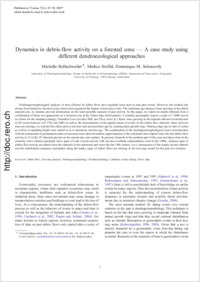Dynamics in debris-flow activity on a forested cone — A case study using different dendroecological approaches
- Bollschweiler, Michelle Laboratory of Dendrogeomorphology, Groupe de Recherche en Géomorphologie (GReG), Department of Geosciences, Geography, University of Fribourg, Switzerland
- Stoffel, Markus Laboratory of Dendrogeomorphology, Groupe de Recherche en Géomorphologie (GReG), Department of Geosciences, Geography, University of Fribourg, Switzerland -
- Schneuwly, Dominique M. Laboratory of Dendrogeomorphology, Groupe de Recherche en Géomorphologie (GReG), Department of Geosciences, Geography, University of Fribourg, Switzerland
-
24.05.2007
Published in:
- Catena. - 2008, vol. 72, no. 1, p. 67-78
Debris flow
Tree-ring analysis
Dendrogeomorphology
Dendrochronology
Landform surface dating
Swiss Alps
English
Dendrogeomorphological analyses of trees affected by debris flows have regularly been used to date past events. However, this method has always been limited to forested cones where trees registered the impact of previous events. The minimum age dating of trees growing in the debris deposits can, in contrast, provide information on the latest possible moment of past activity. In this paper, we report on results obtained from a combination of these two approaches on a forested cone in the Valais Alps (Switzerland). A detailed geomorphic map in a scale of 1:1000 served as a basis for the sampling strategy. Disturbed Larix decidua Mill. and Picea abies (L.) Karst. trees growing in the deposits allowed reconstruction of 49 events between AD 1782 and 2005 as well as the determination of the spatial extent of events. In the debris-flow channels where survivor trees are missing, we selected the oldest post-event trees and assessed their age by counting their growth rings. Missing rings due to lack of center as well as to sampling height were added so as to determine real tree age. The combination of the dendrogeomorphological event reconstruction with the assessment of germination dates of successor trees allowed realistic approximation of the minimum time elapsed since the last debris-flow activity in 23 of the 29 channels present on the current-day cone surface. In general, channels in the northern part of the cone and those close to the currently active channel generally show signs of (sub-) recent activity with one last overbank sedimentation event in the 1980s, whereas signs of debris-flow activity are absent from the channels in the outermost part since the late 19th century. As a consequence of the deeply incised channel and the stabilization measures undertaken along the banks, signs of debris flows are missing in the tree-ring record for the past two decades.
- Faculty
- Faculté des sciences et de médecine
- Department
- Département de Géosciences
- Language
-
- English
- Classification
- Geography
- License
-
License undefined
- Identifiers
-
- RERO DOC 8416
- DOI 10.1016/j.catena.2007.04.004
- Persistent URL
- https://folia.unifr.ch/unifr/documents/300519
Statistics
Document views: 274
File downloads:
- pdf: 323
